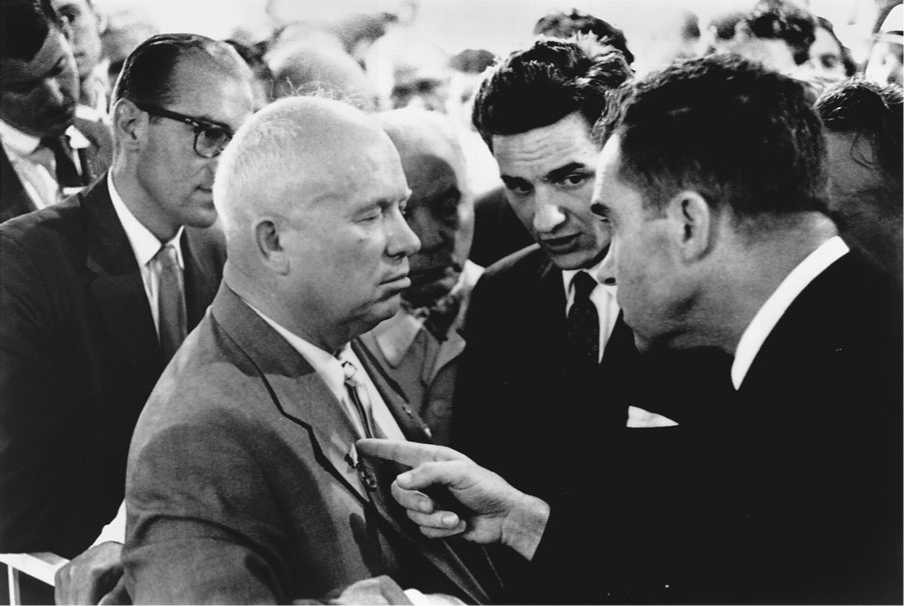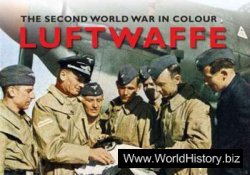In 1956 Eisenhower was reelected, defeating Adlai Stevenson even more decisively than he had in 1952. Despite evident satisfaction with their leader, however, the American people were in a sober mood.

Vice President Richard M. Nixon and Soviet leader Nikita Khrushchev engage in a "kitchen debate” over the future of capitalism at a Moscow trade fair in 1959. Although the encounter did little to advance United States-Soviet relations, it established Nixon's credentials as a tough negotiator.
Hopes of pushing back the Soviet Union with clever stratagems and moral fervor were fading. Although the United States detonated the first hydrogen bomb in November 1952, the Soviets followed suit within six months. The Cold War between the superpowers had become yet more chilling.
Stalin died in March 1953, and after a period of internal conflict within the Kremlin, Nikita Khrushchev emerged as the new master of the Soviet Union. Khrushchev was perhaps the most confusing (and, arguably, confused) figure of the Cold War. Crude and bibulous, prone to violent tantrums and tearful histrionics, he delighted in shocking people with words and gestures. In the most famous of these, he pounded his shoe on the table during a debate at the United Nations. He appealed to the anti-Western prejudices of countries just emerging from the yoke of colonialism, offering them economic aid and pointing to Soviet achievements in science and technology as proof that communism would vanquish the capitalist system without troubling to destroy it by force. Although a product of the Soviet system, Khrushchev recognized its deep failings and resolved to purge it of Stalinism. He released political prisoners from Stalin’s gulags, or political prison camps, and told wide-eyed party functionaries that Stalin had committed monstrous crimes.
Eisenhower, a seasoned analyst of military capabilities, understood that Khrushchev’s antics were meant to conceal the Soviet Union’s many weaknesses: the bitter opposition to Soviet rule among peoples of Eastern Europe; the deficiencies of the overcentralized Soviet economy, especially in agriculture; and the bureaucratic stultification of its armed forces. The Soviet Union had kept up a good pace in the nuclear arms race but had not attained nuclear parity. Thousands of American airplanes were based in Europe, northern Africa, and Turkey, placing most Soviet targets within easy range. Heavy Soviet bombers, on the other hand, faced the daunting prospect of lumbering thousands of miles over the Arctic and Pacific Oceans to reach American targets, harried all the while by lightning-fast fighter planes. The United States would win (whatever that meant) any nuclear war.
But this advantage disappeared in the exhaust trail of a Soviet rocket, launched on October 4, 1957, that carried a 184-pound capsule named Sputnik far above the atmosphere into earth orbit. Soon, American policymakers knew, Soviet missiles capable of reaching American soil would be tipped with nuclear warheads. The nation’s far-flung network of bomber defenses had become obsolete, and with it the strategy of massive retaliation.
Table 28.1 The Cold War Escalates
|
Year |
Event |
Significance |
|
1947 |
George Kennan's "Sources of Soviet Conduct" |
Outlines rationale for "con-tainment"of Soviet Union |
|
1947 |
Truman Doctrine |
United States supports Greece and Turkey against communist threats |
|
1948 |
Marshall Plan |
United States provides economic aid to Western Europe |
|
1949 |
Soviet Union detonates atom bomb |
Truman calls for development of hydrogen bomb |
|
1950 |
North Korea invades South Korea |
Truman intervenes, as does communist China |
|
1950 |
NSC-68 adopted |
Truman authorizes worldwide expansion of U. S. military to stop Soviet aggression anywhere |
|
1952 |
United States detonates hydrogen bomb |
Soviet Union follows suit,1953 |
|
1953 |
NSC-68 replaced with "Massive retaliation" |
Dulles-Eisenhower signal willingness to start a nuclear war to defend American interests |
|
1957 |
Soviet Union launches Sputnik |
Shows Soviet capacity to hit American targets with nuclear weapons |
Several weeks later Khrushchev rubbed hard at the rawest sore in the American psyche: the anguished memory of Pearl Harbor. In an interview with publisher William Randolph Hearst, Jr., Khrushchev blustered that the Soviet Union could launch ten or twenty intercontinental missiles with nuclear warheads “tomorrow.” While critics at home flayed Eisenhower for allowing a “missile gap” with the Soviet Union, the president testily reassured the American people that they had little to fear, but otherwise remained silent.
As a prudent military man, however, Eisenhower refused to take chances. He secretly authorized high-altitude American planes to spy on key Soviet military installations. On May 1, 1960, high over Sverdlovsk, an industrial center deep in the Soviet Union, an American U-2 spy plane was shot down by antiaircraft fire. The pilot of the plane survived the crash, and he confessed to being a spy. His cameras contained aerial photographs of Soviet military installations. When Eisenhower assumed full responsibility for the mission, Khrushchev accused the United States of “piratical” and “cowardly” acts of aggression. He also told the United Nations that the Soviet Union was turning out nuclear missiles “like sausages from an automatic machine.”




 World History
World History









